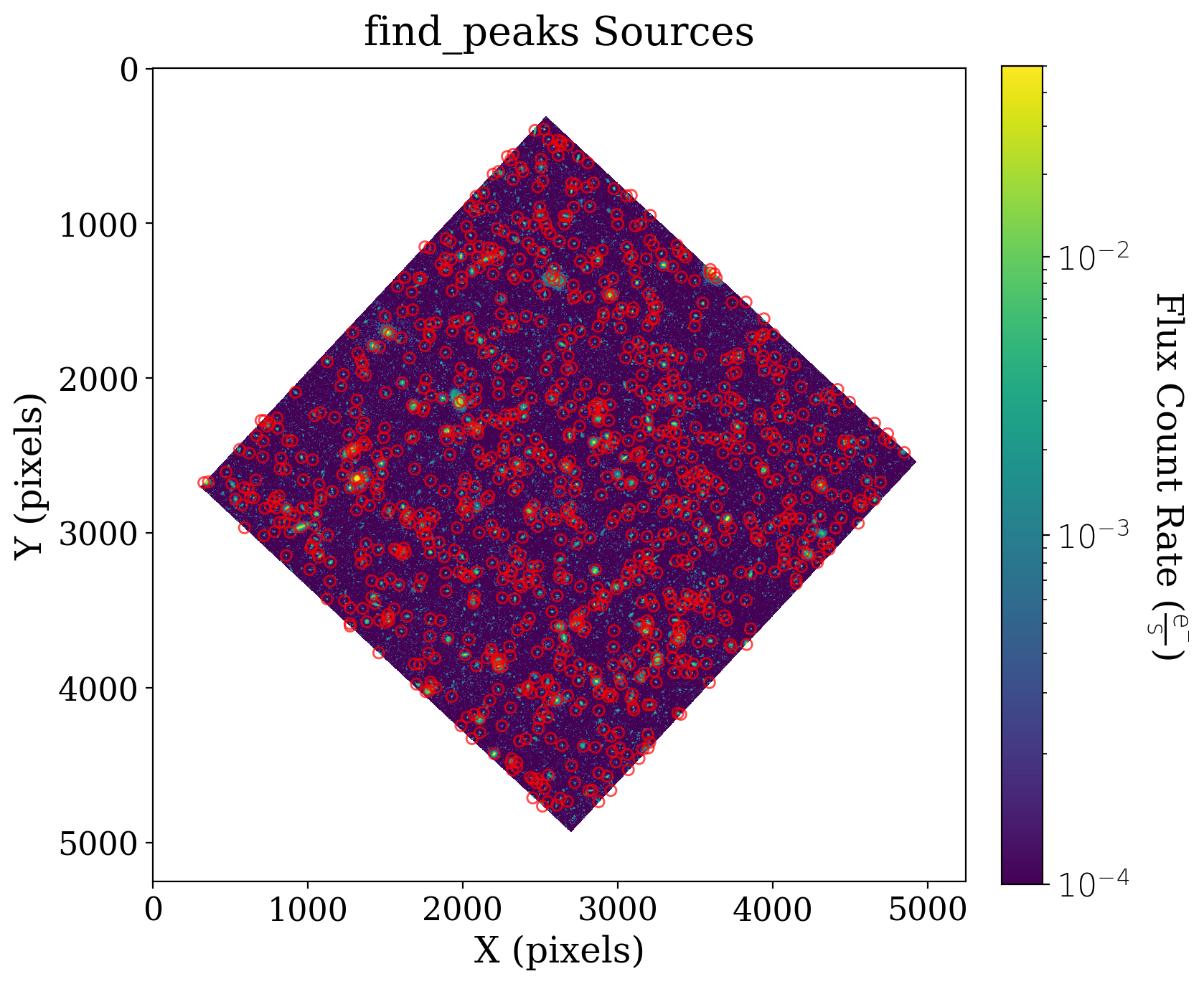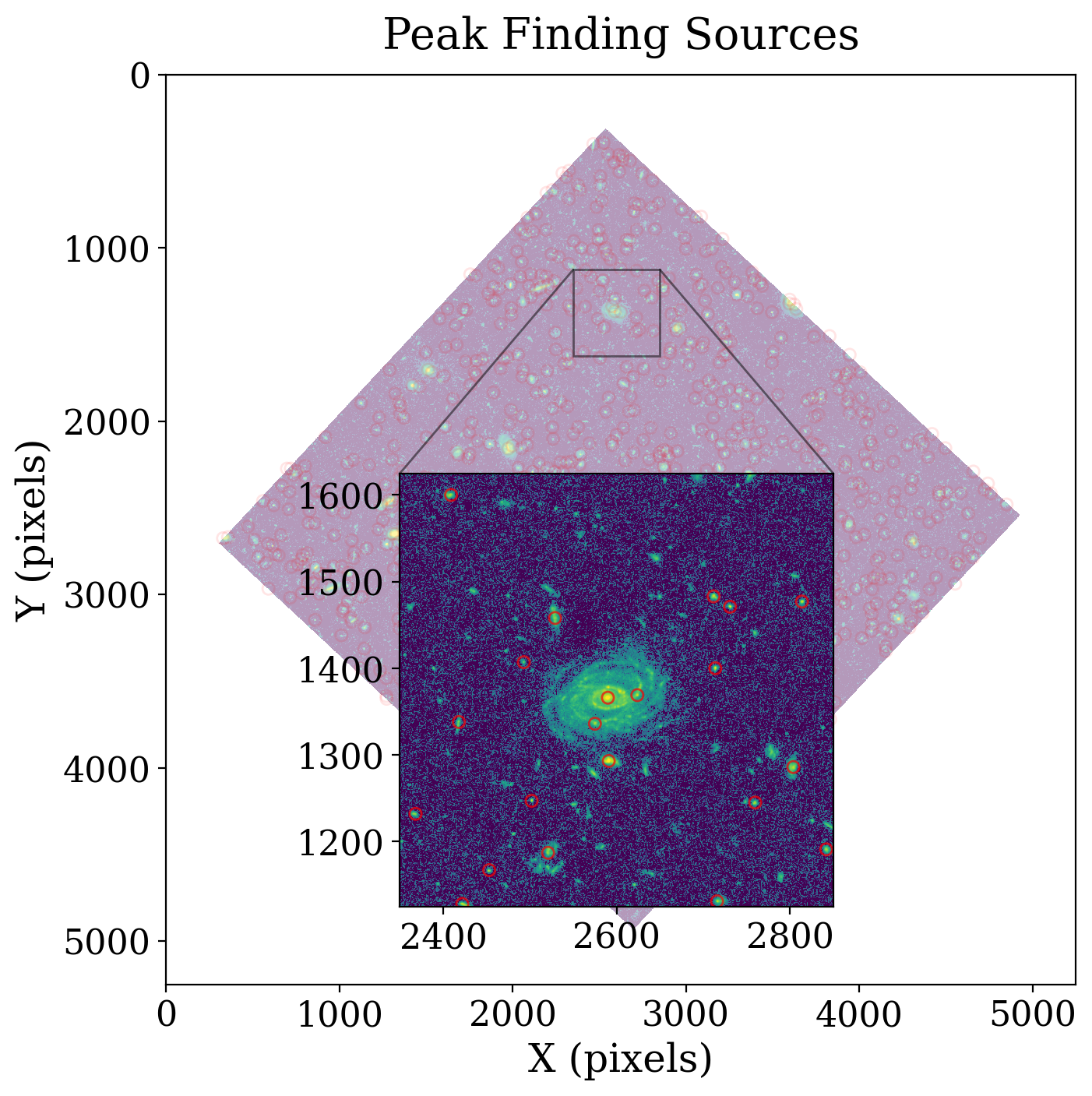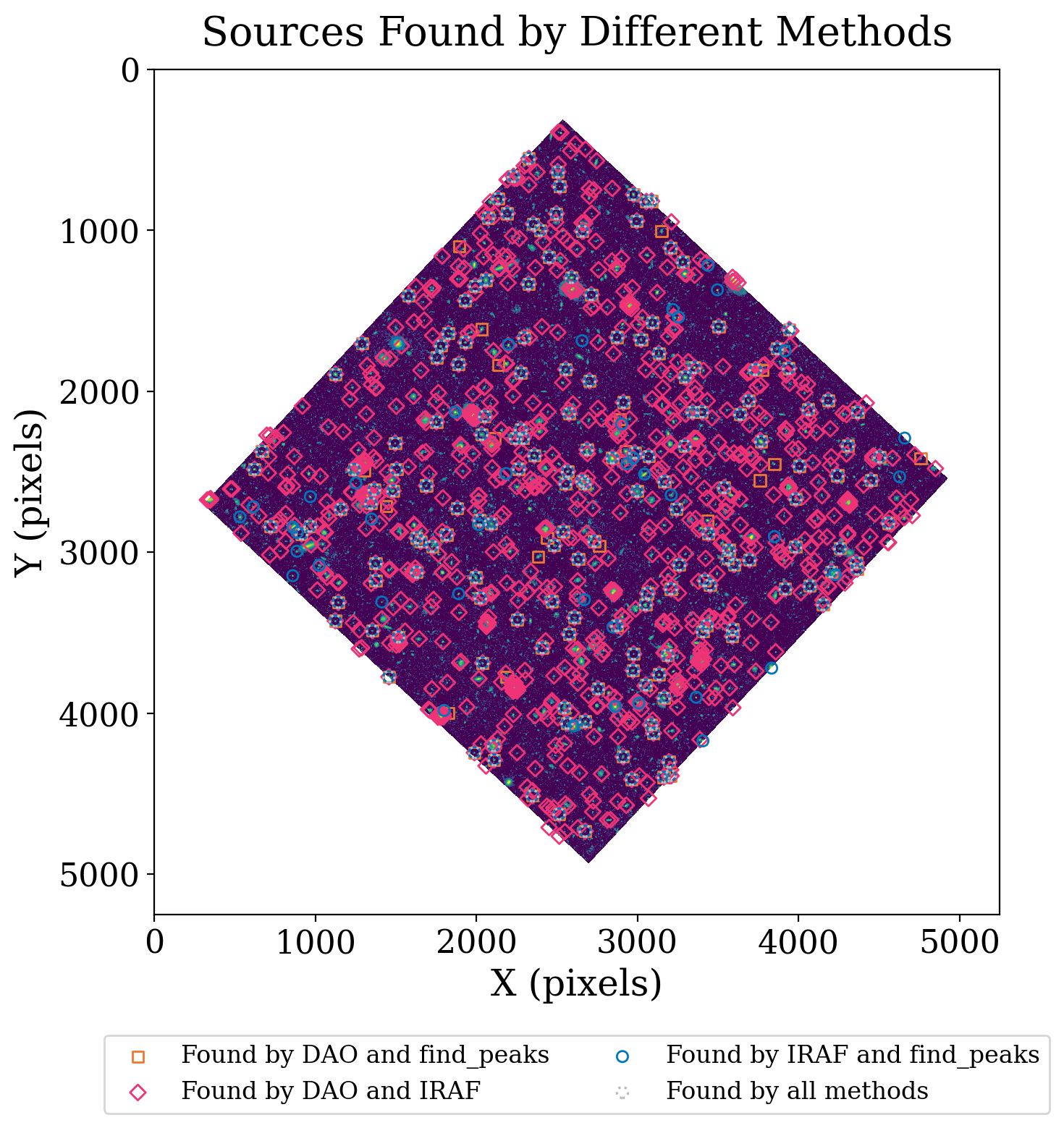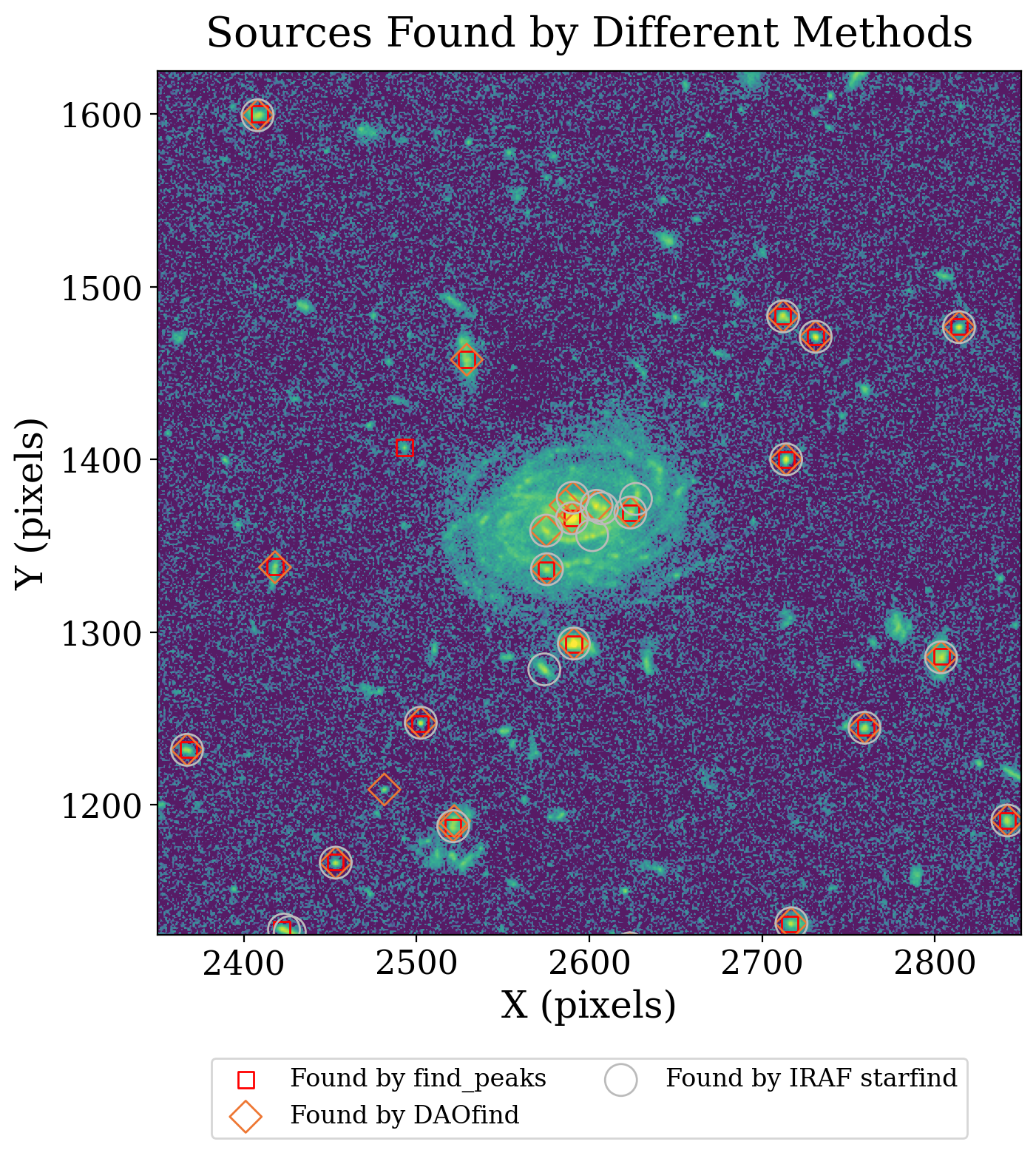8.3.2. Peak finding in the XDF#
8.3.2.1. Data for this notebook#
We will be manipulating Hubble eXtreme Deep Field (XDF) data, which was collected using the Advanced Camera for Surveys (ACS) on Hubble between 2002 and 2012. The image we use here is the result of 1.8 million seconds (500 hours!) of exposure time, and includes some of the faintest and most distant galaxies that had ever been observed.
The methods demonstrated here are also available in the photutils.detection documentation.
The original authors of this notebook were Lauren Chambers, Erik Tollerud and Tom Wilson.
We begin with imports.
import warnings
from astropy.nddata import CCDData
from astropy.stats import sigma_clipped_stats, SigmaClip
import astropy.units as u
from astropy.visualization import ImageNormalize, LogStretch
import matplotlib.pyplot as plt
from matplotlib.ticker import LogLocator
import numpy as np
from photutils.background import Background2D, MeanBackground
from photutils.centroids import centroid_2dg
from photutils.detection import find_peaks, DAOStarFinder, IRAFStarFinder
# Show plots in the notebook
%matplotlib inline
Next, we load the image and calculate the background statistics.
xdf_image = CCDData.read('hlsp_xdf_hst_acswfc-60mas_hudf_f435w_v1_sci.fits')
# Define the mask
mask = xdf_image.data == 0
xdf_image.mask = mask
mean, median, std = sigma_clipped_stats(xdf_image.data, sigma=3.0, maxiters=5, mask=xdf_image.mask)
plt.style.use('../photutils_notebook_style.mplstyle')
8.3.2.2. Source Detection with peak finding#
For more general source detection cases that do not require comparison with models, photutils offers the find_peaks function.
This function simply finds sources by identifying local maxima above a given threshold and separated by a given distance, rather than trying to fit data to a given model. Unlike the previous detection algorithms, find_peaks does not necessarily calculate objects’ centroids. Unless the centroid_func argument is passed a function like photutils.centroids.centroid_2dg that can handle source position centroiding, find_peaks will return just the integer value of the peak pixel for each source.
The centroid-finding, which we do here only so that we can compare positions found by this method to positions found by the star-finding methods, can generate many warnings when an attempt is made to fit a 2D Gaussian to the sources. The warnings are suppressed below to avoid cluttering the output.
Let’s see how it does:
with warnings.catch_warnings(action="ignore"):
sources_findpeaks = find_peaks(xdf_image.data - median, mask=xdf_image.mask,
threshold=20. * std, box_size=29,
centroid_func=centroid_2dg)
print(sources_findpeaks)
id x_peak y_peak peak_value x_centroid y_centroid
---- ------ ------ ----------- ------------------ ------------------
1 2525 393 0.13548362 2525.7825499490064 393.88055503239474
2 2466 400 0.029366337 2465.7798479347243 398.05573502870715
3 2552 459 0.018309232 2553.144113059114 458.5071866239441
4 2614 463 0.018226365 2612.9628856780873 463.90212782823716
5 2635 471 0.021132588 2635.6120154601685 473.07924452934066
6 2635 493 0.08027035 2634.6718726918175 492.2803943395769
7 2678 496 0.026410304 2677.4804921300647 496.9715217867422
8 2586 507 0.037171733 2585.462527787139 507.3101665735999
9 2326 554 0.018130405 2325.528858931348 553.6418835727972
10 2616 560 0.021488318 2615.938885064026 559.9740345848103
... ... ... ... ... ...
1024 2836 4662 0.01867783 2828.840372102822 4661.979368247575
1025 2956 4663 0.030241651 2957.43798265238 4664.380775142155
1026 2814 4664 0.016782979 2818.781489666815 4662.160254025871
1027 2452 4711 0.04217213 2449.2187375121634 4711.273878402247
1028 2631 4712 0.015904581 2630.494634031711 4712.276375599891
1029 2676 4733 0.014843852 2676.3994552743634 4733.100046176483
1030 2549 4736 0.015206217 2551.5624408418103 4733.959834146592
1031 2878 4736 0.03463787 2879.7315243346816 4737.664616308867
1032 2607 4758 0.019089993 2603.851675357389 4761.25199341925
1033 2515 4764 0.02098297 2499.6013132419002 4716.863606119463
Length = 1033 rows
There are roughly 1,000 sources identified in the image. Recall from the notebook on star-finding detection methods that roughly 1,500 sources were found with DAOStarFinder.
# Set up the figure with subplots
fig, ax1 = plt.subplots(1, 1, figsize=(8, 8))
# Plot the data
# Set up the normalization and colormap
norm_image = ImageNormalize(vmin=1e-4, vmax=5e-2, stretch=LogStretch(), clip=False)
cmap = plt.get_cmap('viridis')
cmap.set_bad('white') # Show masked data as white
fitsplot = ax1.imshow(np.ma.masked_where(xdf_image.mask, xdf_image.data),
norm=norm_image, cmap=cmap)
ax1.scatter(sources_findpeaks['x_peak'], sources_findpeaks['y_peak'], s=30, marker='o',
lw=1, alpha=0.7, facecolor='None', edgecolor='r')
# Define the colorbar
cbar = plt.colorbar(fitsplot, fraction=0.046, pad=0.04, ticks=LogLocator())
def format_colorbar(bar):
# Add minor tickmarks
bar.ax.yaxis.set_minor_locator(LogLocator(subs=range(1, 10)))
# Force the labels to be displayed as powers of ten and only at exact powers of ten
bar.ax.set_yticks([1e-4, 1e-3, 1e-2])
labels = [f'$10^{{{pow:.0f}}}$' for pow in np.log10(bar.ax.get_yticks())]
bar.ax.set_yticklabels(labels)
format_colorbar(cbar)
# Define labels
cbar.set_label(r'Flux Count Rate ({})'.format(xdf_image.unit.to_string('latex')),
rotation=270, labelpad=30)
ax1.set_xlabel('X (pixels)')
ax1.set_ylabel('Y (pixels)')
ax1.set_title('find_peaks Sources');

We once again look at region around the large galaxy. A comparison of this approach with the star-finding approaches appears later in this section.
fig, ax = plt.subplots(figsize=(8, 8))
top = 1125
left = 2350
cutout_size = 500
inset_display_size = 5 * cutout_size
fitsplot = ax.imshow(xdf_image, cmap=cmap, norm=norm_image, alpha=0.4)
ax.scatter(sources_findpeaks['x_peak'], sources_findpeaks['y_peak'], s=30, marker='o',
lw=1, alpha=0.1, facecolor='None', edgecolor='r')
ax.set_xlabel('X (pixels)')
ax.set_ylabel('Y (pixels)')
ax.set_title('Peak Finding Sources')
ax2 = ax.inset_axes([2600 - inset_display_size // 2, 2300, inset_display_size, inset_display_size],
xlim=(left, left + cutout_size), ylim=(top, top + cutout_size),
transform=ax.transData)
ax.indicate_inset_zoom(ax2, edgecolor="black")
ax2.imshow(xdf_image, cmap=cmap, norm=norm_image)
in_region = (
(left < sources_findpeaks['x_peak']) &
(sources_findpeaks['x_peak'] < (left + cutout_size)) &
(top < sources_findpeaks['y_peak']) &
(sources_findpeaks['y_peak'] < (top + cutout_size))
)
sources_findpeaks_to_plot = sources_findpeaks[in_region]
ax2.scatter(sources_findpeaks_to_plot['x_peak'], sources_findpeaks_to_plot['y_peak'], s=30, marker='o',
lw=1, alpha=0.7, facecolor='None', edgecolor='r');

8.3.2.3. Comparing Detection Methods#
Let’s compare how each of these different strategies did.
First, we repeat our earlier detection using DAOStarFinder and IRAFStarFinder.
daofind = DAOStarFinder(fwhm=5.0, threshold=20. * std)
sources_dao = daofind(np.ma.masked_where(xdf_image.mask, xdf_image))
iraffind_match = IRAFStarFinder(fwhm=5.0, threshold=20. * std,
sharplo=0.2, sharphi=1.0,
roundlo=-1.0, roundhi=1.0,
minsep_fwhm=0.0)
sources_iraf_match = iraffind_match(np.ma.masked_where(xdf_image.mask, xdf_image))
print(f'''DAOStarFinder: {len(sources_dao)} sources
IRAFStarFinder: {len(sources_iraf_match)} sources
find_peaks: {len(sources_findpeaks)} sources''')
DAOStarFinder: 1470 sources
IRAFStarFinder: 1415 sources
find_peaks: 1033 sources
Next, how many of these sources match? We can answer this question by using sets to compare the centroids of the different sources (rounding to the nearest integer).
# Make lists of centroid coordinates
centroids_dao = [(x, y) for x, y in sources_dao['xcentroid', 'ycentroid']]
centroids_iraf = [(x, y) for x, y in sources_iraf_match['xcentroid', 'ycentroid']]
centroids_findpeaks = [(x, y) for x, y in sources_findpeaks['x_centroid', 'y_centroid']]
# Round those coordinates to the ones place and convert them to be sets
rounded_centroids_dao = set([(round(x, 0), round(y, 0)) for x, y in centroids_dao])
rounded_centroids_iraf = set([(round(x, 0), round(y, 0)) for x, y in centroids_iraf])
rounded_centroids_findpeaks = set([(round(x, 0), round(y, 0)) for x, y in centroids_findpeaks])
# Examine the intersections of different sets to determine which sources are shared
all_match = rounded_centroids_dao.intersection(rounded_centroids_iraf).intersection(rounded_centroids_findpeaks)
dao_iraf_match = rounded_centroids_dao.intersection(rounded_centroids_iraf)
dao_findpeaks_match = rounded_centroids_dao.intersection(rounded_centroids_findpeaks)
iraf_findpeaks_match = rounded_centroids_iraf.intersection(rounded_centroids_findpeaks)
print(f'''Matching sources found by:
All methods: {len(all_match)}
DAOStarFinder & IRAFStarFinder: {len(dao_iraf_match)}
DAOStarFinder & find_peaks: {len(dao_findpeaks_match)}
IRAFStarFinder & find_peaks: {len(iraf_findpeaks_match)}''')
Matching sources found by:
All methods: 172
DAOStarFinder & IRAFStarFinder: 975
DAOStarFinder & find_peaks: 191
IRAFStarFinder & find_peaks: 213
And just for fun, let’s plot these matching sources. (The colors chosen to represent different sets are from Paul Tol’s guide for accessible color schemes.)
# Set up the figure with subplots
fig, ax1 = plt.subplots(1, 1, figsize=(8, 8))
# Plot the data
fitsplot = ax1.imshow(np.ma.masked_where(xdf_image.mask, xdf_image), norm=norm_image)
ax1.scatter([x for x, y in list(dao_findpeaks_match)], [y for x, y in list(dao_findpeaks_match)],
s=30, marker='s', lw=1, facecolor='None', edgecolor='#EE7733',
label='Found by DAO and find_peaks')
ax1.scatter([x for x, y in list(dao_iraf_match)], [y for x, y in list(dao_iraf_match)],
s=30, marker='D', lw=1, facecolor='None', edgecolor='#EE3377',
label='Found by DAO and IRAF')
ax1.scatter([x for x, y in list(iraf_findpeaks_match)], [y for x, y in list(iraf_findpeaks_match)],
s=30, marker='o', lw=1, facecolor='None', edgecolor='#0077BB',
label='Found by IRAF and find_peaks')
ax1.scatter([x for x, y in list(all_match)], [y for x, y in list(all_match)],
s=30, marker='o', lw=1.2, linestyle=':',facecolor='None', edgecolor='#BBBBBB',
label='Found by all methods')
# Add legend
ax1.legend(ncol=2, loc='lower center', bbox_to_anchor=(0.5, -0.25))
# Define labels
ax1.set_xlabel('X (pixels)')
ax1.set_ylabel('Y (pixels)')
ax1.set_title('Sources Found by Different Methods');

This is pretty cluttered, so we once again look at the region around the large galaxy in the image.
fig, ax1 = plt.subplots(1, 1, figsize=(8, 8))
# Plot the data
fitsplot = ax1.imshow(np.ma.masked_where(xdf_image.mask, xdf_image), norm=norm_image, alpha=0.9)
marker_size = 60
ax1.scatter(sources_findpeaks['x_peak'], sources_findpeaks['y_peak'], s=marker_size, marker='s',
lw=1, alpha=1, facecolor='None', edgecolor='r', label='Found by find_peaks')
ax1.scatter(sources_dao['xcentroid'], sources_dao['ycentroid'], s=2 * marker_size, marker='D',
lw=1, alpha=1, facecolor='None', edgecolor='#EE7733', label='Found by DAOfind')
ax1.scatter(sources_iraf_match['xcentroid'], sources_iraf_match['ycentroid'],
s=4 * marker_size, marker='o', lw=1, alpha=1, facecolor='None', edgecolor='#BBBBBB',
label="Found by IRAF starfind")
# Add legend
ax1.legend(ncol=2, loc='lower center', bbox_to_anchor=(0.5, -0.25))
top = 1125
left = 2350
cutout_size = 500
ax1.set_xlim(left, left + cutout_size)
ax1.set_ylim(top, top + cutout_size)
# Define labels
ax1.set_xlabel('X (pixels)')
ax1.set_ylabel('Y (pixels)')
ax1.set_title('Sources Found by Different Methods');

There is only one actual source in this cutout that was found by one of the star-finding techniques that were not also found by peak finding. Several sources ideintified as separate by star-finding sources in the large galaxy at the center are not actually separate. Peak finding suffers from this too but to a lesser extent.
8.3.2.4. Custom Detection Algorithms#
If none of the algorithms we’ve reviewed above do exactly what you need, photutils also provides infrastructure for you to generate and use your own source detection algorithm: the StarFinderBase object can be inherited and used to develop new star-finding classes. Take a look at the documentation for more information.
If you do go that route, remember that photutils is open source; you would be very welcome to open a pull request and incorporate your new star finder into the photutils source code – for everyone to use!
8.3.2.5. Summary#
The sources found by find_peaks are roughly the same as those found by the star-finding algorithms. In XX BROKEN LINK SEGMENTATION we will look at a much different approach that is especially well suited to finding extended objects.

